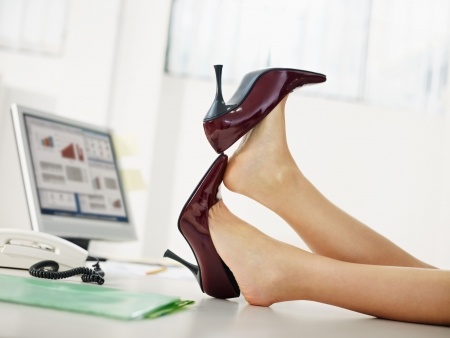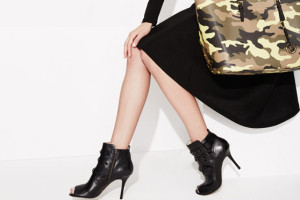We Spoke With Podiatrist, Dr. Lori Grant, to Learn How to Keep Feet Healthy in Heels
Your love affair began the second you saw him through the window; you fixated on the sleek line of French style, sexy-hot in pink and tragically high. You immediately picture the two of you gliding down the corridor toward your office, going to lunch dates, playing footsie under the boardroom table…
 Ultimately, you suspect he will bring you pain, but you are drawn to Christian (Louboutin), moth to flame. Even smart women, women who know better, can’t resist the draw of an amazing pair of sharp heels, which makes it even more important to know how to save your feet and legs from sharp pain.
Ultimately, you suspect he will bring you pain, but you are drawn to Christian (Louboutin), moth to flame. Even smart women, women who know better, can’t resist the draw of an amazing pair of sharp heels, which makes it even more important to know how to save your feet and legs from sharp pain.
We love high heels from strappy stillettos to patent pumps, but no woman is immune to the leg aches, swollen feet and corns that can often accompany the well-heeled shoe. Heels cause some foot and leg issues, while they only exacerbate others. When asked her opinion of women wearing heels, Lori Grant, DPM, said, “I know women are going to wear heels. We wear them to look professional. Wearing heels is not bad.” Dr. Grant cautioned that wearing heels for 8-12 hours a day, on the other hand, might cause or exacerbate some foot and leg issues.
Fit. Well-fitting shoes keep pain and damage to a minimum. While the temptation to purchase the last pair of those gorgeous pumps even though they are a half size too small is huge, resist the urge. Too-small shoes compress bones and have the potential to cause nerve damage. Ill-fitting shoes also contribute to corns and calluses that occur when friction causes a thickening of the skin where shoes rub. Small pads are available to reduce the friction in trouble spots. Some manufacturers are incorporating comfort and foot health into their designs, including additional padding at pressure points to increase comfort.
Heel Height. Some women have no trouble walking in higher heels, while others teeter and wobble in them. A narrow or skinny stiletto heel offers little support on which to balance weight on the foot. Dr. Grant suggested women, “change out the height of their heels” to avoid wearing 4” heels everyday. Alternate shoes daily, wearing low-heeled pumps, platform stilettos or a wedge heel. Choose a heel height that is comfortable to you. A wedge, for example, offers comanding height with a greater stability and more equal spread of weight to all parts of the foot. Look for platform stilettos that have a platform built up under the ball of the foot. Dr. Grant said, “A 4” platform stiletto with a 1 ½ “platform is the equivalent of a 3 ½ “heel.”
Stability. The bulk of support in a shoe comes from the heel. A strong heel that fits a woman’s heel snuggly, without the heel sliding around, is the better option. Wobbly heels contribute to simple annoyances like swollen feet and squished toes, and to larger problems like ankle sprains and nerve damage. Arch support is important as well, even in a heel. When a shoe doesn’t support the arch, it can stretch the plantar fascia and cause pain. Women notice this most often when stepping out of bed first thing in the morning.
Toe Box. Pointy-toed shoes come in and out of style and women love the look, but take care to buy heels with a toe box that is comfortable for you. Too tight shoes that pinch the toes contribute to ingrown toenails in the big toe. Pressure on the toe pushes the nail into the nail bed, causing pain and inflammation. If toes slip forward in heels toward the front of the shoe, pad the ball of the foot with any of the many pads available that stick to the shoe and keep the foot from sliding forward. If your shoe has a pointed toe, make sure the shoe doesn’t begin to narrow until past the ball of the foot.
Tootsie Treatments. “Wearing heels shortens the Achilles tendon,”Dr. Grant said. If you wear heels, it is important to create an evening, foot care routine to ease the stress on your feet and legs. Try wrapping a towel or scarf around the toes and gently pulling toward the body to stretch the tendons in the foot. Stretch tired calf muscles nightly by flexing the foot and stretching the Achilles tendon. To relieve swollen feet at the end of a grueling day in heels, place a plastic water bottle, filled with water and then frozen, under the foot and roll it back and forth to stretch the foot and cool tendons. Rubbing in peppermint lotion will soften feet while making them feel tingly and energized. If you can kick your heels off under your desk during the day, go ahead.
Dr. Grant advised if you notice any of the following, it’s time to visit a podiatrist:
– Pain on the back of the heel (Achilles tendonitis)
– Aches/pain in the ball of the foot
– A bump forming at the juncture of the big toe and foot (bunion)
– Toes starting to curl (hammertoes)
Let’s face it; to most women giving up heels comes about as easily as giving up chocolate. You can wear those stellar stilettos as long as you take care of your tootsies in between. When not donning those hot pink, Sharp Heels, give your feet and legs the rest they deserve.
12TAGS: Shoes
 Effective Communication
Effective Communication Women Making History
Women Making History Grants & Funding Sources
Grants & Funding Sources Interview Prep
Interview Prep Impactful Leadership
Impactful Leadership Dressing for Work
Dressing for Work Dressing for Your Style
Dressing for Your Style Interview Style Tips
Interview Style Tips Women's Stocking Stuffers
Women's Stocking Stuffers Gift the Busy Traveler
Gift the Busy Traveler Airport Layover Activities
Airport Layover Activities Traveling & Eating Healthy
Traveling & Eating Healthy Travel Like a Boss Lady
Travel Like a Boss Lady The Dual California Life
The Dual California Life Gifts for Thanksgiving
Gifts for Thanksgiving Summer Reading List
Summer Reading List Top Leisurely Reads
Top Leisurely Reads New Year, New Books
New Year, New Books Life Lessons from a Sitcom
Life Lessons from a Sitcom Oprah, Amy or Amal?
Oprah, Amy or Amal?







